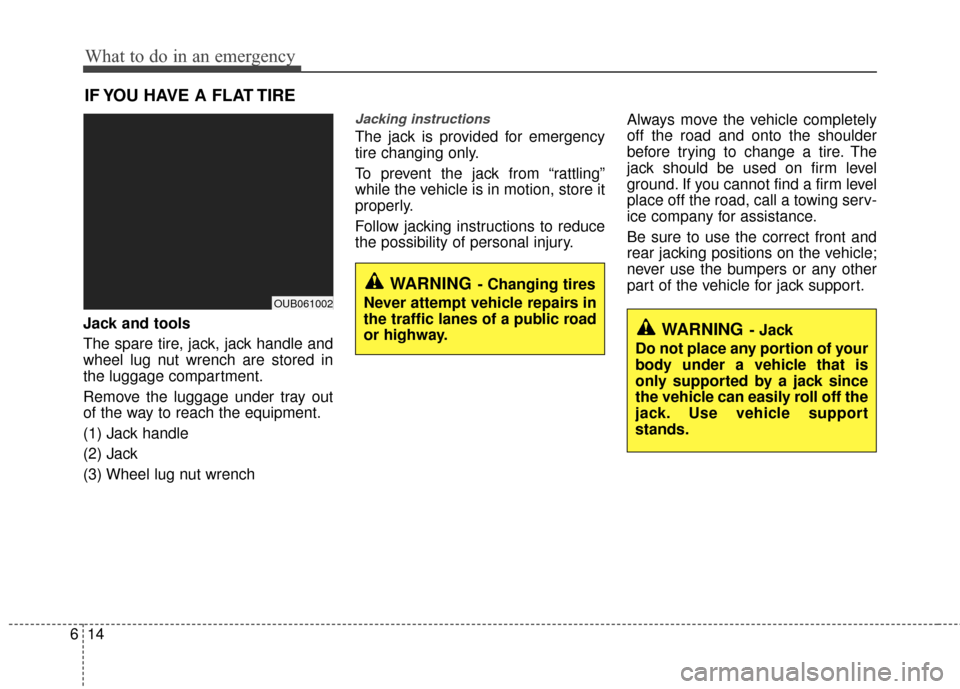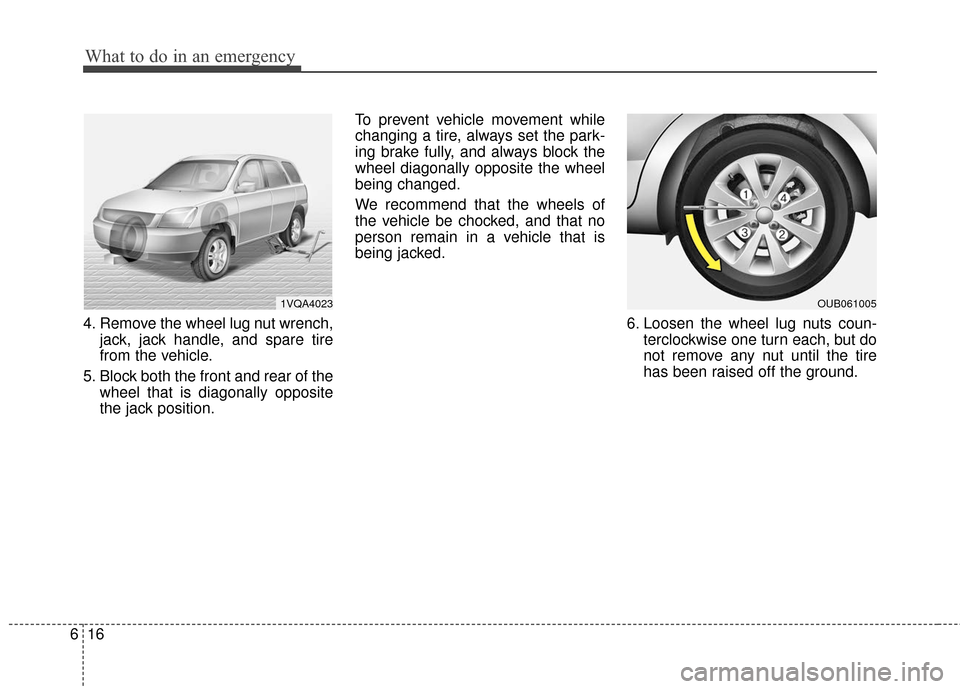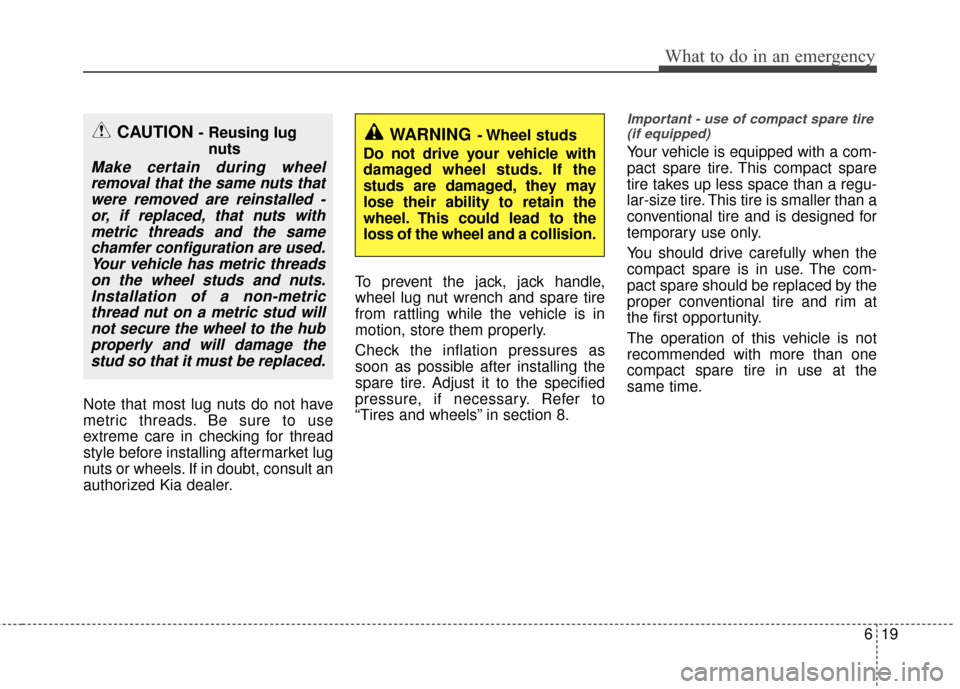2016 KIA Rio Spare tire and jack
[x] Cancel search: Spare tire and jackPage 319 of 449

What to do in an emergency
14
6
IF YOU HAVE A FLAT TIRE
Jack and tools
The spare tire, jack, jack handle and
wheel lug nut wrench are stored in
the luggage compartment.
Remove the luggage under tray out
of the way to reach the equipment.
(1) Jack handle
(2) Jack
(3) Wheel lug nut wrench
Jacking instructions
The jack is provided for emergency
tire changing only.
To prevent the jack from “rattling”
while the vehicle is in motion, store it
properly.
Follow jacking instructions to reduce
the possibility of personal injury. Always move the vehicle completely
off the road and onto the shoulder
before trying to change a tire. The
jack should be used on firm level
ground. If you cannot find a firm level
place off the road, call a towing serv-
ice company for assistance.
Be sure to use the correct front and
rear jacking positions on the vehicle;
never use the bumpers or any other
part of the vehicle for jack support.
WARNING- Jack
Do not place any portion of your
body under a vehicle that is
only supported by a jack since
the vehicle can easily roll off the
jack. Use vehicle support
stands.
WARNING- Changing tires
Never attempt vehicle repairs in
the traffic lanes of a public road
or highway.
OUB061002
Page 320 of 449

615
What to do in an emergency
Do not allow anyone to remain in the
vehicle while it is on the jack.
Make sure any children present are
in a secure place away from the road
and from the vehicle to be raised with
the jack.Removing and storing the spare
tire
Turn the tire hold-down wing bolt
counterclockwise.
Store the tire in the reverse order of
removal.
To prevent the spare tire and tools
from “rattling” while the vehicle is in
motion, store them properly.Changing tires
1. Park on a level surface and apply
the parking brake firmly.
2. Shift the shift lever into R (Reverse) for manual transaxle or
P (Park) for automatic transaxle.
3. Activate the hazard warning flash- er.
OED066033
WARNING- Running vehi-
cle on jack
Do not start or run the engine of
the vehicle while the vehicle is
on the jack as this may cause
the vehicle to fall off the jack.
OUB061003
Page 321 of 449

What to do in an emergency
16
6
4. Remove the wheel lug nut wrench,
jack, jack handle, and spare tire
from the vehicle.
5. Block both the front and rear of the wheel that is diagonally opposite
the jack position. To prevent vehicle movement while
changing a tire, always set the park-
ing brake fully, and always block the
wheel diagonally opposite the wheel
being changed.
We recommend that the wheels of
the vehicle be chocked, and that no
person remain in a vehicle that is
being jacked.
6. Loosen the wheel lug nuts coun-terclockwise one turn each, but do
not remove any nut until the tire
has been raised off the ground.
1VQA4023OUB061005
Page 322 of 449

617
What to do in an emergency
7. Place the jack at the front or rearjacking position closest to the tire
you are changing. Place the jack
at the designated locations under
the frame. The jacking positions
are plates welded to the frame
with two tabs and a raised dot to
index with the jack. 8. Insert the jack handle into the jack
and turn it clockwise, raising the
vehicle until the tire just clears the
ground. This measurement is
approximately 30 mm (1 in). Before
removing the wheel lug nuts, make
sure the vehicle is stable and that
there is no chance for movement or
slippage. 9. Loosen the wheel nuts and
remove them with your fingers.
Slide the wheel off the studs and
lay it flat so it cannot roll away. To
put the wheel on the hub, pick up
the spare tire, line up the holes
with the studs and slide the wheel
onto them. If this is difficult, tip the
wheel slightly and get the top hole
in the wheel lined up with the top
stud. Then jiggle the wheel back
and forth until the wheel can be
slid over the other studs.
Wheels and wheel covers may have
sharp edges. Handle them carefully
to avoid possible injury. Before put-
ting the wheel into place, be sure
that there is nothing on the hub or
wheel (such as mud, tar, gravel, etc.)
that prevents the wheel from fitting
solidly against the hub.
OUB065008OUB061006
Page 324 of 449

619
What to do in an emergency
Note that most lug nuts do not have
metric threads. Be sure to use
extreme care in checking for thread
style before installing aftermarket lug
nuts or wheels. If in doubt, consult an
authorized Kia dealer.To prevent the jack, jack handle,
wheel lug nut wrench and spare tire
from rattling while the vehicle is in
motion, store them properly.
Check the inflation pressures as
soon as possible after installing the
spare tire. Adjust it to the specified
pressure, if necessary. Refer to
“Tires and wheels” in section 8.
Important - use of compact spare tire
(if equipped)
Your vehicle is equipped with a com-
pact spare tire. This compact spare
tire takes up less space than a regu-
lar-size tire. This tire is smaller than a
conventional tire and is designed for
temporary use only.
You should drive carefully when the
compact spare is in use. The com-
pact spare should be replaced by the
proper conventional tire and rim at
the first opportunity.
The operation of this vehicle is not
recommended with more than one
compact spare tire in use at the
same time.
CAUTION - Reusing lug nuts
Make certain during wheelremoval that the same nuts thatwere removed are reinstalled -or, if replaced, that nuts withmetric threads and the samechamfer configuration are used.Your vehicle has metric threadson the wheel studs and nuts.Installation of a non-metricthread nut on a metric stud willnot secure the wheel to the hubproperly and will damage thestud so that it must be replaced.
WARNING- Wheel studs
Do not drive your vehicle with
damaged wheel studs. If the
studs are damaged, they may
lose their ability to retain the
wheel. This could lead to the
loss of the wheel and a collision.
Page 444 of 449

Index
4I
Engine number ··················\
··················\
··················\
·········8-10
Engine oil ··················\
··················\
··················\
·················7-34\
Changing the engine oil and filter ··················\
·············7-35
Checking the engine oil level ··················\
··················\
7-34
ENGINE START/STOP button ··················\
··················\
···5-7 ENGINE START/STOP button position ··················\
·····5-7
Illuminated ENGINE START/STOP button·················\
·5-7
Explanation of scheduled maintenance items ···············7-31
Exterior overview I ··················\
··················\
··················\
····2-2
Exterior overview II ··················\
··················\
··················\
···2-3
Fuel filler lid ··················\
··················\
··················\
············4-30 Closing the fuel filler lid ··················\
··················\
·········4-30
Fuel requirements ··················\
··················\
··················\
····1-3
Fuel requirements Opening the fuel filler lid ··················\
··················\
········4-30
Fuses ··················\
··················\
··················\
··················\
······7-61 Engine compartment fuse panel ··················\
················7-67
Fuse/relay panel description ··················\
··················\
····7-65
Instrument panel fuse panel··················\
··················\
·····7-66
Memory fuse··················\
··················\
··················\
··········7-63 Hazard warning flasher ··················\
··················\
··············4-72
Hood··················\
··················\
··················\
··················\
·······4-28
Closing the hood··················\
··················\
··················\
····4-29
Opening the hood ··················\
··················\
··················\
·4-28
How to use this manual ··················\
··················\
···············1-2
If the engine overheats··················\
··················\
·················6-8
If the engine will not start ··················\
··················\
···········6-4 If engine turns over normally but does not start ···········6-4
If the engine doesn't turn over or turns over slowly······6-4
If you have a flat tire ··················\
··················\
·················6-14\
Changing tires ···············\
··················\
··················\
··········6-15
Jack and tools ··················\
··················\
··················\
········6-14
Removing and storing the spare tire ··················\
·······6-15
If you have a flat tire (Tire Mobility Kit) ··················\
····6-22 Components of the Tire Mobility Kit··················\
········6-24
Distributing the sealant ··················\
··················\
············6-26
Introduction ··················\
··················\
··················\
···········6-22
Notes on the safe use of the Tire Mobility Kit ···········6-23
Using the Tire Mobility Kit ··················\
··················\
·····6-25
In case of an emergency while driving ··················\
··········6-3 If engine stalls while driving ··················\
··················\
·····6-3H
F
I